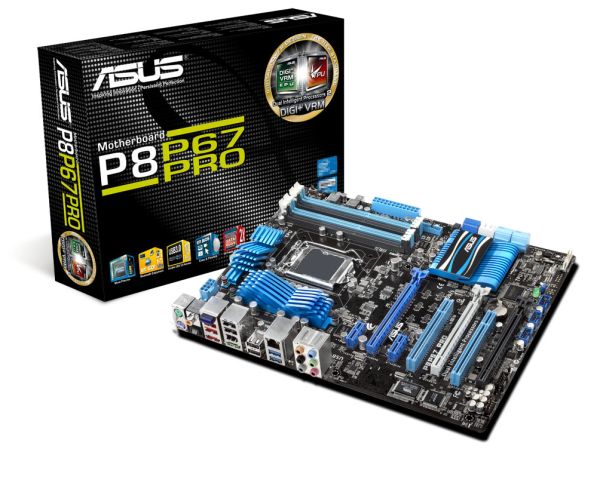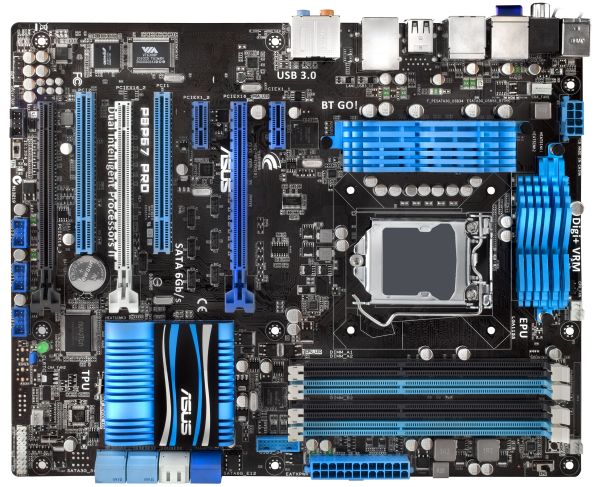A brief look at upcoming ASUS P67 Motherboards
by Ian Cutress on November 14, 2010 1:22 PM EST- Posted in
- News
- Motherboards
- Asus
On first inspection, this board’s aesthetic blue and black livery is impressive. The big blue heatsinks on the VRM, while looking good with a large surface area, intrude slightly on the socket, potentially resulting in restricting the orientation of high end air coolers.
Among the standard features you’d expect on a P67, such as the four dual-channel DDR3 slots, and four SATA 3Gb/s with two SATA 6Gb/s supported by the chipset, there is another two SATA ports, but it is unclear if these are for the RAID, 3Gb/s or 6Gb/s, or how they are powered, as they are not labelled and the chipset heatsink covers quite a bit. Two NEC controllers give two USB 3.0 ports on the back panel, and the possibility for another two via a header on the board connectable to the case, or to an ASUS USB 3.0 port box (as shown in the P67 Deluxe images). The Sandy Bridge platform on P67 relies on discrete graphics only, and as such there are no video out connectors on the back panel, but two PCIe x8 slots on the board itself (or one PCIe x16 if only one card is used). There is another PCIe slot available, presumably x4, for non-GPU duties.
The back panel itself is fairly standard – dual PS/2 ports for keyboard and mouse, S/PDIF out, six USB 2.0 ports, two USB 3.0 ports, two eSATA connectors, firewire, 5.1 audio and gigabit Ethernet. Also of note is the Bluetooth receiver, which is a nice addition, but the lack of a second gigabit Ethernet port, which by now we feel should be a staple on all high end boards and any board with the ‘Pro’ moniker, isn’t too pleasing.
On the board, we see two switches for TPU (TurboV Processing Unit) and EPU (Energy Processing Unit). The TPU is designed to monitor FET thermal temperatures, while the EPU will moderate power appropriately across the VRMs. Both can be turned on and off by the onboard switches, and presumably in the BIOS as well.
Speaking of switches, we’re disappointed that ASUS have not put easy-to-use power and reset switches on the Pro. Sure, not everyone needs them, but they are a nice addition rather than having to short two front panel pins with a screwdriver (when slightly tired, it’s never a good idea to accidentally short the wrong pins, unless you want to see some sparks).












53 Comments
View All Comments
neoflux - Monday, November 15, 2010 - link
I think you're right, the image from the techreport article is "p8h67-i.jpg"http://techreport.com/r.x/asus-sb-mobos/p8h67-i.jp...
Wardrop - Monday, November 15, 2010 - link
Can someone explain to me why PCI is still alive and kicking. 6+ years after PCI-e became mainstream, we're still seeing PCI slots on motherboards. Why are Intel so stingy with how many PCI-e lanes their chipsets support?When will PCI finally rest in peace?
By the way, I realise that legacy support is sometimes required in some industries, but not every mainstream motherboard needs two PCI slots (the vast majority don't need any).
DanNeely - Monday, November 15, 2010 - link
Probably because each PCIe lane needs a bit of dedicated hardware and dedicated traces on the mobo to support it, vs legacy PCI daisychaining all its devices on the same bus. In Intel's case this is aggravated by DMIs relatively low bandwidth limiting the number of lanes that the southbridge can support without bottlenecking.As far as the bus actually dieing completely... Your current mobo almost certainly still implements a variant of ISA in the form of the LPC bus which has the PS2 ports, Floppy controller, and BIOS attached. On server type boards the connector for a TPM device is also wired into LPC. It's possible that the minimal differences between PCI and PCIe (vs ISA and PCI) will result in PCI dieing completely, but since ISA has lingered over a decade after its slots disappeared I wouldn't hold my breath.
http://en.wikipedia.org/wiki/Low_Pin_Count
strikeback03 - Monday, November 15, 2010 - link
I care more about the slots disappearing than the bus itself. Not so big a deal on full-size ATX boards, but with uATX and only 4 slots it is annoying that an otherwise good board might have 2 PCI and 2 PCIe when you might need/want more PCIe. Someone needs to take the lead in pushing the removal of PCI from the majority of products.DanNeely - Monday, November 15, 2010 - link
3 and 1 does makes more sense on a mATX board, and aside from filling space on the board itself I don't see much need for more than 1 of them. The only thing that would make me hesitate a bit on an all PCIe board is that I can't find a PCIe bios post code reader.Unfortunately with 1155 though, at least for high end boards there might not be enough lanes available to go all PCIe even on an mATX board. The CPU's 16 lanes power the two 16x slots in 16/0 or 8/8 modes. The southbridge only has 8 1x lanes. USB3 and Sata6GB controllers take 2 lanes each. GigE controllers will take 1 or 2 more, leaving at most 2 or 3 lanes left. IF operating the two 16x physical slots in 16/1 mode is an option there goes another lane. Likewise if PCIe audio or wireless controllers are also shoehorned onboard.
LGA1155 will help on this front somewhat by upping the southbridge lanes to 2.0 speeds, and providing 2 sata6Gb ports on the southbridge. In theory this would allow for a 16(8)/16(8)/4/1 configuration. Although board designers can undo these gains by sticking more than 1 USB3 controller or additional Sata6GB controllers onboard.
Without using NF200 chips to multiplex PCIe lanes though I don't think we'll see any LGA1155 full size ATX boards that completely shed PCI though. LGA2011's 36 (40?) 3.0 + 8 2.0 lanes will probably be able to do it.
I fear that their marketing people might be drawing the wrong conclusions from (presumed) lackluster sales of pricey legacy-free boards.
A final comment I'd like to make is that the people who wrote the PCIe physical spec missed a trick that the original PCI designers did to help the transition from ISA. Because PCI and ISA slots have the physical connection on the opposite side of the case opening you could make PCI/ISA slots that had both connectors side by side. Unlike in the bad old days, PCIe 1x slots barely take any physical space, so fitting them next to the single PCI slot you're keeping for legacy use wouldn't have nearly as much of an impact in figuring out how to cram everything onto the board.
jonup - Monday, November 15, 2010 - link
Is socket 1155 would be compatible with scket 1156 coolers? I have a Mugen2 that I pulled out from my P2 machine in anticipation of bulding a new rig. And now that I have my mind set on SB I am really anxious to know.blowfish - Monday, November 15, 2010 - link
Surely it's high time PS2 ports were dropped. With the minimal cost of keyboards and mice, it can be no great hardship to replace old PS2 devices with USB ones. And maybe dropping the PS2 ports might have allowed a second ethernet port.DanNeely - Monday, November 15, 2010 - link
The cost from the connector is negligible, as is the board space for connecting the PS2 controller; and with the exception of the mITX board they all had enough space to fit a 2nd ethernet port or another bank of USB ports on the back. Even there the mITX board probably could've dropped the VGA connection in favor of a DVI-D plug and a dongle to get the needed space.The reason PS2 ports still live on in so many mobos is for the benefit of BIOS/low level OS driver developers. Because PS2 is orders of magnitude simpler than USB it's much less vulnerable to a buggy software build leaving the system without a means of user input for troubleshooting/disaster recovery.
Mr Perfect - Monday, November 15, 2010 - link
Normally, I'd be right there with you. The BIOS writers and low level driver coders probably aren't using ASUS ROG boards, so why's it on there?The only reasonable reason I've seen to date to have a PS\2 port is N-Key rollover for keyboards(NKRO). If you have a NKRO keyboard, PS\2 can identify every individual key, even if you somehow manage to mash them all down at once. Even with the best keyboard, USB can only recognize six keys at a time plus modifiers(Alt, Ctrl, Shift, etc). Ever been playing a game, go to hit oooone more key and have it not register? Yep, that wouldn't happen with NKRO. The Geekhack keyboardists explain it much better of course.
http://geekhack.org/showwiki.php?title=Do+I+need+N...
I know of no good reason to use a mouse on PS\2 though.
Dimarini - Monday, November 15, 2010 - link
Please forgive me if someone else posted this ... "Obviously, expect the Deluxe to retail at a high price than the Pro." ... Should this read "higher"?